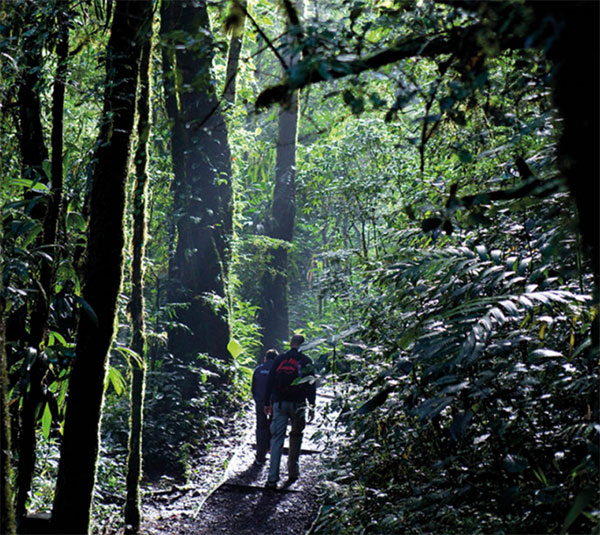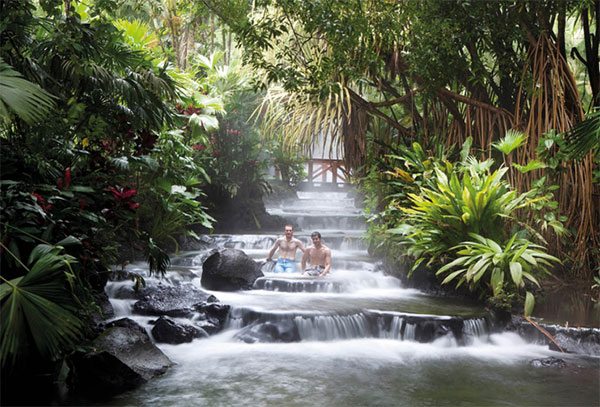CARNAVAL IN PUERTO LIMÓN
For many people, Puerto Limón’s annual Carnaval (Carnival) is the best reason to visit the place. This week-long jubilant event is held every October (rather than in February, the usual carnival month elsewhere). It is not an ancient Puerto Limón tradition: Carnival first began here in 1949, under the leadership of a barber called Alfred Henry King, who timed the festivities to coincide with the anniversary of Christopher Columbus’s landing near Limón on October 18, 1502. El Día de la Raza, ‘The Day of the People,’ which falls during Carnival Week and traditionally includes the participation of the Indigenous peoples who live in the region, has been renamed Día de las Culturas (Day of the Cultures) in recognition of the fact that not everyone remembers Columbus with equal affection. It is also a tribute to the contributions made to Costa Rica by people of various different cultures.
The highlight of Carnival Week is the parade, when local people joined by thousands of visitors take to the streets to revel in a glorious music and dance spectacle. The drums, the heat, the shining bodies of dancers and drummers in bright costumes, urge spectators to abandon their inhibitions and to surrender to the Caribbean beat. And so they do, Limonenses and tourists alike, filling the streets, shimmying, shaking, singing, and carousing, while the irresistible rhythms of steel drums fill the warm, humid air.
Opposite the Hotel Heliconia, on the road to Santa Elena, follow the signs to El Jardín de las Mariposas (Butterfly Garden; daily 9am–3.30pm; www.monteverdebutterflygarden.com), which exhibits all the butterfly species of the region.
Fact
The community of Monteverde was established by a group of Quakers who moved here from Alabama in 1951. To support themselves, the Quakers began making cheese from milk brought to their primitive processing plant each morning by Tico dairy farmers. Monteverde cheese has become a proud Costa Rican specialty and can be found in markets throughout Central America.
One of the most popular Monteverde attractions is the Monteverde Park, with its Sky Walk (www.skyadventures.travel), a 2.5km (1.5-mile) series of trails and five hanging bridges suspended Indiana Jones-style from platforms in the tree canopy. The park also offers Sky Trek, a high-speed, high-adrenaline canopy tour that involves donning mountain-climbing harnesses and zipping through the trees suspended on strong cables. A more relaxing experience is the Sky Tram gondolas, which take visitors smoothly up into the rainforest for amazing views accompanied by and informative commentary from a knowledgeable guide. Advance reservations are obligatory.

Hiking in Monteverde cloud forest.
Corrie Wingate/Apa Publications
Around 5km (3 miles) northeast of Monteverde village is an outstanding local initiative, the Reserva Santa Elena (Santa Elena Rainforest Reserve; www.reservasantaelena.org). Comprising some 310 hectares (766 acres) of mixed montane and elfin forest, the reserve was created in 1992 as a local high-school project and includes several kilometers of well-kept paths and a visitors’ center. On clear days, you are treated to views of magnificent Arenal Volcano to the north. Tours are well organized and cheaper than at Monteverde, yet the flora and fauna (including quetzals and howler monkeys) are every bit as impressive. There are four principal trails, all short enough to be done in a day.
Volcán Arenal and around
La Fortuna de San Carlos ^ [map] is a busy, sun-baked village near the base of Arenal Volcano that’s the center for local tours, accommodations, and eateries.
Some 5km (3 miles) east of La Fortuna is the turnoff to the Cataratas del Río Fortuna. These falls are accessible in an hour’s easy horseback ride from La Fortuna through pastures and fields of corn, bananas, and peppers. If you are going to drive, the trip requires a four-wheel-drive vehicle. Once at the falls, a muddy hike down a slippery slope to the swimming area at the base of the falls makes the clear, fresh water all the sweeter. Closer to the volcano, between La Fortuna and Lake Arenal, Tabacón Grand Spa Thermal Resort (www.tabacon.com) is one of Costa Rica’s most popular tourist destinations. From here you can look directly up the volcano’s lava-rock slopes. Volcanologists have predicted that if Arenal erupts, Tabacón Springs will likely be in the path of the lava flow. For the moment the volcano is heating Tabacón’s therapeutic waters to a perfect temperature. Tiled slides, waterfalls, and pools of varying temperatures are surrounded by tumbling warm-water creeks and exquisitely landscaped gardens. Although the springs are often crowded with day-trippers, hotel guests can enjoy volcano views at night from quiet pools under a starry sky.
Just west of La Fortuna, you can luxuriate in the warm mineral waters of the more affordable Baldi Hot Springs (www.baldihotsprings.cr). For US$66 you get a day pass with dinner, and adults can enjoy a warm soak in a plethora of pools with varying temperatures with a volcano view, while children can play on a variety of water slides.
Down the highway, past the Tabacón Hot Springs Resort, is a dirt road to the left leading 9km (5 miles) to Arenal Observatory Lodge (tel: 2290 7011; www.arenalobservatorylodge.com) formerly a volcano research facility for the Smithsonian Institution. It is the only lodge in the national park and the closest accommodations to the volcano, only 2.7km (1.7 miles) away. The lodge has comfortable rooms in bungalows, set on a huge estate with primary and secondary forest, waterfalls, and hiking and horseback trails.
Nuevo Arenal & [map] is a town reborn from the old village of Arenal, in the valley that was flooded in 1973 to create the lake and the huge hydroelectric project here. Along the road to Nuevo Arenal there are some very pleasant small hotels and bed-and-breakfasts. The scenic road winds around the edges of the lake, but drivers need to be aware that although it is paved, it is often washed out, especially during the rainy season.
Laguna de Arenal * [map] offers some of Costa Rica’s most challenging freshwater fishing. Whether or not you choose to fish, do charter a boat and a guide to take you sightseeing on the lake. Better still, set off in a rented kayak. Go in the early morning, when, for much of the year, the lake’s surface is like glass, and the volcano can be viewed as a crystalline reflection.
From December through April, usually in the afternoon, northeasterly winds blow almost daily, and the lake is anything but calm and glassy. Between 40 and 50 knots of sustained breeze whips the west end of the lake into a sea of whitecaps, making it a favorite destination for experienced windsurfers.

Tabacón’s hot springs are a major reason to visit the area.
Corrie Wingate/Apa Publications
The Sarapiquí region
The lush, tropical jungles of the Río Sarapiquí region, on the Caribbean side of the Cordillera Central, are less than 100km (60 miles) east of San José. La Selva Biological Station, Selva Verde Lodge, and Rara Avis, private reserves with lodging, are all accessible via the Braulio Carrillo Highway east of San José, through the spectacular Parque Nacional Braulio Carrillo. Beware of driving the highway after sunset, since thick night fog blankets this steep, winding route.
The small, colorful port town of Puerto Viejo de Sarapiquí ( [map] is where river boats loaded with tourists take scenic trips on jungle waterways with naturalist guides to point out the monkeys, birds, and other riverside animals along the way. You can also take a full-day trip up the Sarapiquí to the Río San Juan, on the Nicaraguan border; be sure to bring along your passport because the river crosses into Nicaraguan territory.